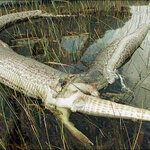Ecology & Zoology

Nearly all of the 162 land-breeding frog species on Caribbean islands, including the coqui frogs of Puerto Rico, originated from a single frog species that rafted on a sea voyage from South America about 30-to-50-million years ago, according to DNA-sequence analyses led by a research group at Penn State.
Similarly, the scientists found that the Central American relatives of these Caribbean amphibians also arose from a single species that arrived by raft from South America.
"This discovery is surprising because no previous theories of how the frogs arrived had predicted a single origin for…
According to years of research both in the test tube and, now, with real plants, a team of scientists reports that artificial chemicals in pesticides – through application or exposure to crops through runoff – disrupt natural nitrogen-fixing communications between crops and soil bacteria. The disruption results in lower yields or significantly delayed growth.
Alfalfa roots secrete chemical signals into soil to attract and recruit bacteria. These bacteria live in a plant's roots and provide a natural fertilizer source. Pictured is an alfalfa root with root hairs that have attracted rhizobia…

Field trials could be underestimating the potential for cross-pollination between GM and conventional crops, according to new research by the University of Exeter. The research team recommends a new method for predicting the potential for cross-pollination, which takes account of wind speed and direction.
The research, published in the journal Ecological Applications, used records of wind speed and direction from weather stations across Europe to predict the movement of pollen in the air. The findings show huge variation in the amount of cross-pollination between GM and non-GM crops of maize…
The Tropical Eastern Pacific, a discrete biogeographic region that has an extremely high rate of endemism among its marine organisms, continues to yield a wealth of never-before-described marine animals to visiting scientists at the Smithsonian Tropical Research Institute in Panama. Alicia Hermosillo, researcher at the Universidad de Guadalajara in Mexico, and Angel Valdes, assistant curator of Malacology at the Natural History Museum of Los Angeles County, describe five newly discovered species of nudibranchs, two of which Hermosillo collected in Panama.
Cuthona behrensi, one of five new…

In a night sky filled with hungry bats, good-tasting moths increase their chances of survival by mimicking the sounds of their bad-tasting cousins, according to a new Wake Forest University study.
The study is the first to definitively show how an animal species uses acoustic mimicry as a defensive strategy. The research was conducted by Jesse Barber, a doctoral student in biology at Wake Forest. William E. Conner, professor of biology at Wake Forest, co-authored the study.
In response to the sonar that bats use to locate prey, the tiger moths make ultrasonic clicks of their own. They…

Thanks to Janine for pointing out this story of a python which burst open after gobbling up a Florida gator. The strange scene was found by park rangers in the Everglades National Park. The Burmese python is likely an escaped pet or perhaps a descendant of one. In recent years many guilt-ridden owners release their exotic pets into the hot and wet swampy environment because they are no longer able to take care of them and do not want them put down.
Because pythons are not natural to the environment, the rangers suspect that they challenge the alligators' position as apex predators in the food…

Sharks are known to have a keen sense of smell, which in many species is critical for finding food. However, according to new research from Boston University marine biologists, sharks can not use just their noses to locate prey; they also need their skin – specifically a location called the lateral line.
The lateral line is an organ used by all fish to detect, with exquisite sensitivity, movement and vibration in the surrounding water. According to the research team, this is similar to how humans can sense air flow with the small hairs on the face. Until now, it had not been demonstrated…
Certain army ants in the rainforests of Central and South America conduct spectacular predatory raids containing up to 200,000 foraging ants. Remarkably, some ants use their bodies to plug potholes in the trail leading back to the nest, making a flatter surface so that prey can be delivered to the developing young at maximum speed.
Specialization by a minority can help the greater good. Photo by Scott Powell
The raid always remains connected to the nest by a trail of forager traffic, along which prey-laden foragers run back to run back to the nest. This trail can be extremely uneven and full…

In the tropics, even the birds know how to relax better than those in the north. Tropical birds expend less energy at rest than do birds living in more northern climates, according to a study published online this week in the Proceedings of the National Academy of Sciences.
Take a tip from tropical birds. Enjoy life a little.
“We found that tropical birds have a slow pace of life which is reflected in how much energy they spend to stay alive,” said Joseph Williams, co-author of the study and associate professor of evolution, ecology and organismal biology at Ohio State University.
“This is…

A new study in the May issue of the Journal of Wildlife Management reports that scientists from the New York State Museum, Wildlife Conservation Society and other groups have teamed up with the New York State Department of Criminal Justice to developed a new technique that uses fingerprints to track the fisher--an elusive member of the weasel family, and the only carnivore species known to have unique fingerprints.
Scientists recovered this camera trap photo of a fisher, an elusive member of the weasel family. Credit: Wildlife Conservation Society
Fingerprints left behind at special…